

WEEK 11: MARCH 8-14
TOPIC: COMET 1P/HALLEY
To our ancestors of just a few centuries ago, comets were, at best, mysterious objects, very possibly of divine or supernatural origin. When one considers that bright comets could appear anywhere in the nighttime sky, seemingly out of nowhere, and after being visible for a few days or weeks would then disappear, it is little wonder why they thought so. Only gradually did human understanding of comets grow to the point where we know that they are regular members of our solar system – albeit still very interesting and worthy of study for a variety of reasons.
What could be considered the watershed moment in our understanding of comets is due to a British astronomer, Edmond Halley, who was born in Haggerston in 1656. Halley had a productive and colorful career, including two decades as Britain’s “Astronomer Royal.” He made many contributions to astronomy and other sciences, perhaps one of the most important of these being the “proper motion” of stars and thus the fact that stars, including our sun, travel through space. He was a contemporary and friend of the eminent British physicist Isaac Newton, and funded the publishing of the latter’s treatise Philosophiae Naturalis Principia Mathematica (Latin for Mathematical Principles of Natural Philosophy) – usually called the Principia – in 1687, wherein he described his laws of motion and gravitation.
In the early 18th Century Halley decided to apply Newton’s technique to calculating the orbits of 24 historical comets. Upon doing so he noticed that three of them, which had appeared in 1531, in 1607, and in 1682 (which he himself had observed as a young man), had orbits strikingly similar to each other, and moreover appeared at approximate intervals of 76 years. Halley then reasoned that these might not be three separate comets, but instead were returns of the same comet with that orbital period. He published his results in early 1705, and made the bold prediction that that same comet would return again in 1758.
Halley passed away in 1742 at the age of 85 and thus did not live to see whether or not his prediction would turn out to be correct. As 1758 approached several astronomers of that era, including the French astronomer Charles Messier who would become a champion discoverer of comets in subsequent decades, began making attempts for it, but these were initially unsuccessful. Finally, on December 25, 1758, a German amateur astronomer, Johann Palitzsch, discovered a comet in the constellation Cetus which a month later was recognized as being the long-awaited comet predicted by Halley. The actual perihelion date was March 13, 1759, and it became a conspicuous naked-eye object; meanwhile, in honor of his prediction and his recognition that comets are regular members of the solar system, the comet has been referred to as “Halley’s Comet” ever since.
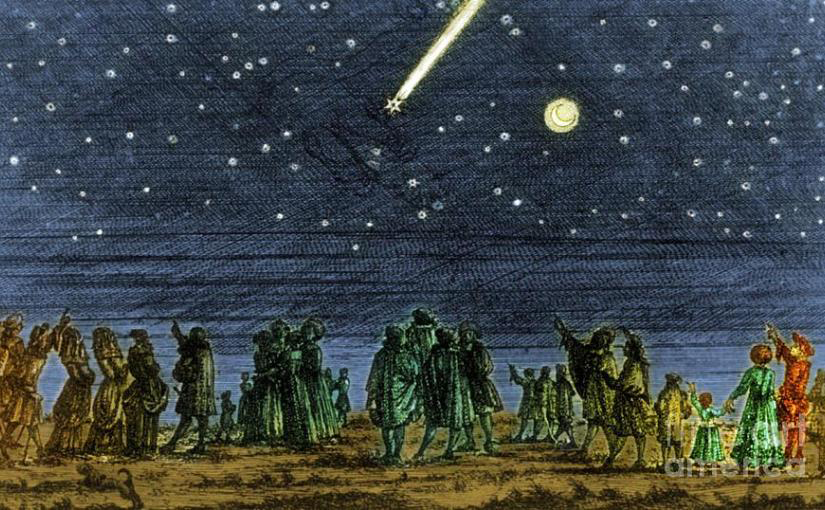
 LEFT: Comet Halley in 1682 over Augsburg, Bavaria. RIGHT: Comet Halley over London in 1759, as painted by British artist Samuel Scott. Westminster Abbey is on the far left.
LEFT: Comet Halley in 1682 over Augsburg, Bavaria. RIGHT: Comet Halley over London in 1759, as painted by British artist Samuel Scott. Westminster Abbey is on the far left.
Once its periodic nature had been established, it has been possible to identify previous returns of Comet Halley, and indeed every return back to that of 240 B.C. has now been positively identified in the records of the respective times. It has almost always been a conspicuous naked-eye object, and has come quite close to Earth on occasion, the closest approach being to 0.033 AU in A.D. 837; according to Chinese records the tail around that time was approximately 90 degrees long. Other close approaches include ones of 0.088 AU in A.D. 374, of 0.090 AU in A.D. 607, and of 0.104 AU in 1066.
OBSERVED PERIHELION PASSAGES OF COMET 1P/HALLEY, PLUS THE NEXT TWO RETURNS
| PERIHELION | q (AU) | PERIHELION | q (AU) | |
|---|---|---|---|---|
| 240 B.C. May 25.12 | 0.585 | 989 September 5.69 | 0.582 | |
| 164 B.C. November 12.57 | 0.584 | 1066 March 20.93 | 0.574 | |
| 87 B.C. August 6.42 | 0.586 | 1145 April 18.56 | 0.575 | |
| 12 B.C. October 10.85 | 0.587 | 1222 September 28.82 | 0.574 | |
| 66 January 25.96 | 0.585 | 1301 October 25.58 | 0.573 | |
| 141 March 22.43 | 0.583 | 1378 November 10.69 | 0.576 | |
| 218 May 17.72 | 0.581 | 1456 June 9.63 | 0.580 | |
| 295 April 20.40 | 0.576 | 1531 August 26.24 | 0.581 | |
| 374 February 16.34 | 0.577 | 1607 October 27.54 | 0.584 | |
| 451 June 28.25 | 0.574 | 1682 September 15.28 | 0.583 | |
| 530 September 27.13 | 0.576 | 1759 March 13.06 | 0.584 | |
| 607 March 15.48 | 0.581 | 1835 November 16.44 | 0.587 | |
| 684 October 2.77 | 0.580 | 1910 April 20.18 | 0.587 | |
| 760 May 20.67 | 0.582 | 1986 February 9.46 | 0.587 | |
| 837 February 28.27 | 0.582 | 2061 July 28.72 | 0.593 | |
| 912 July 18.67 | 0.580 | 2134 March 27.90 | 0.593 |
The comet has managed to insert itself into our history from time to time. Its return in A.D. 66 was later believed by the Jewish historian Josephus to foretell the destruction of Jerusalem by Roman forces four years later. Its return in 1301 is alleged to have inspired the Italian painter Giotto di Bondone to make a comet represent the Star of Bethlehem in his fresco painting “Adoration of the Magi” in the Scrovegni Chapel in Padua. (The comet, in fact, had returned in 12 B.C.) The European Space Agency’s Giotto mission to the comet in 1986 was named in his honor.
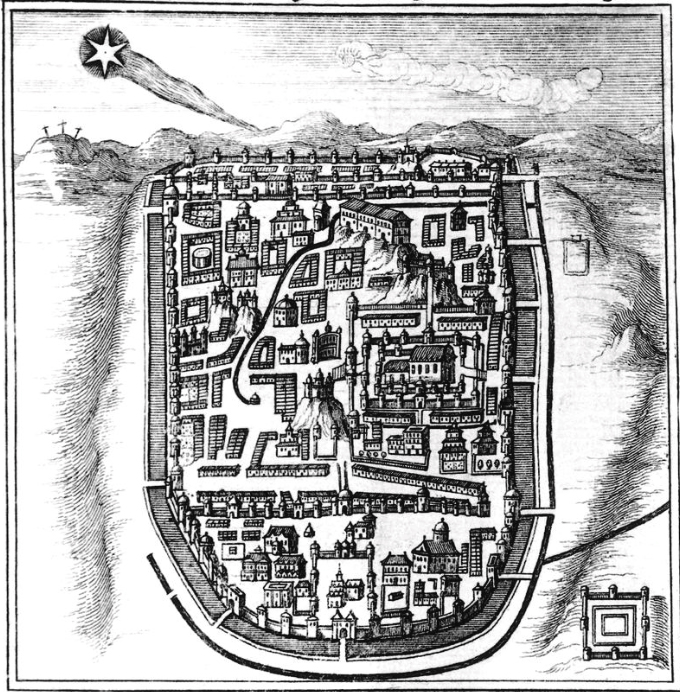
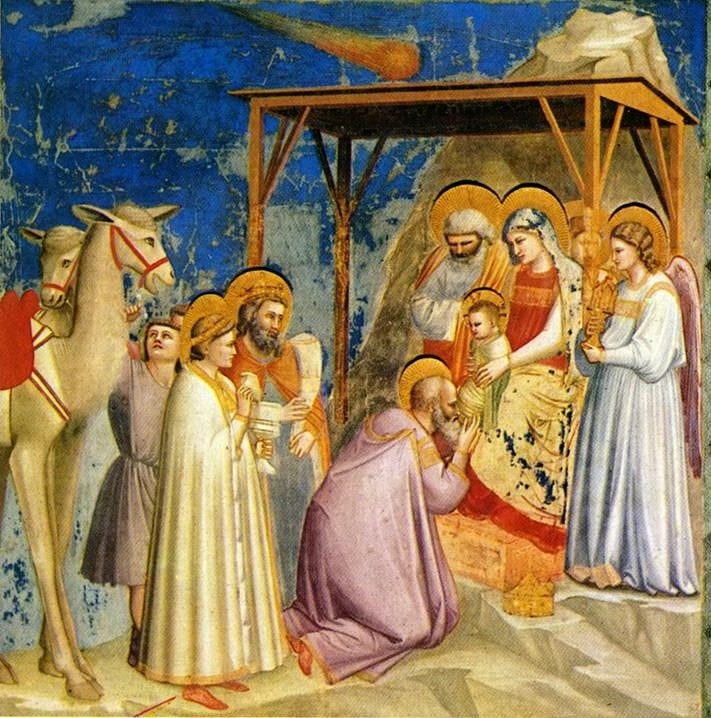 LEFT: Representation of Comet Halley over Jerusalem in A.D. 66, later believed by the Jewish historian Josephus to foretell the city’s forthcoming destruction. Engraving from “Theatrum Cometicum” by Polish scientist Stanislaw Lubieniecki in 1668. RIGHT: The fresco “Adoration of the Magi” by Italian painter Giotto di Bondone in the Scrovegni Chapel in Padua, completed in 1305. Giotto was supposedly inspired by the appearance of Comet Halley in 1301 to include it as the Star of Bethlehem.
LEFT: Representation of Comet Halley over Jerusalem in A.D. 66, later believed by the Jewish historian Josephus to foretell the city’s forthcoming destruction. Engraving from “Theatrum Cometicum” by Polish scientist Stanislaw Lubieniecki in 1668. RIGHT: The fresco “Adoration of the Magi” by Italian painter Giotto di Bondone in the Scrovegni Chapel in Padua, completed in 1305. Giotto was supposedly inspired by the appearance of Comet Halley in 1301 to include it as the Star of Bethlehem.
The return in 1066 not only involved a close approach to Earth, the comet was also apparently unusually bright. It is depicted in the Bayeux Tapestry, which shows King Harold II of England and his aides looking at it fearfully, as they took it as an omen of ill fortune. Across the English Channel, William the Conqueror took it as a good omen and launched his invasion of England; the comet turned out to be a self-fulfilling prophecy in both cases, with William defeating Harold’s forces at the Battle of Hastings. The comet’s return that year is also apparently depicted in Native American petroglyphs at Chaco Canyon in New Mexico.
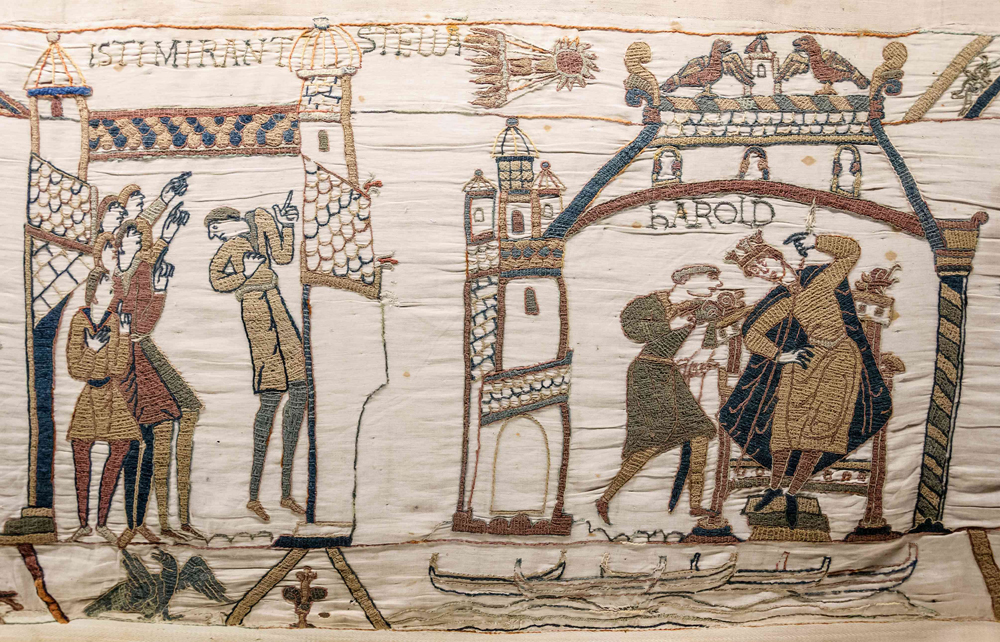
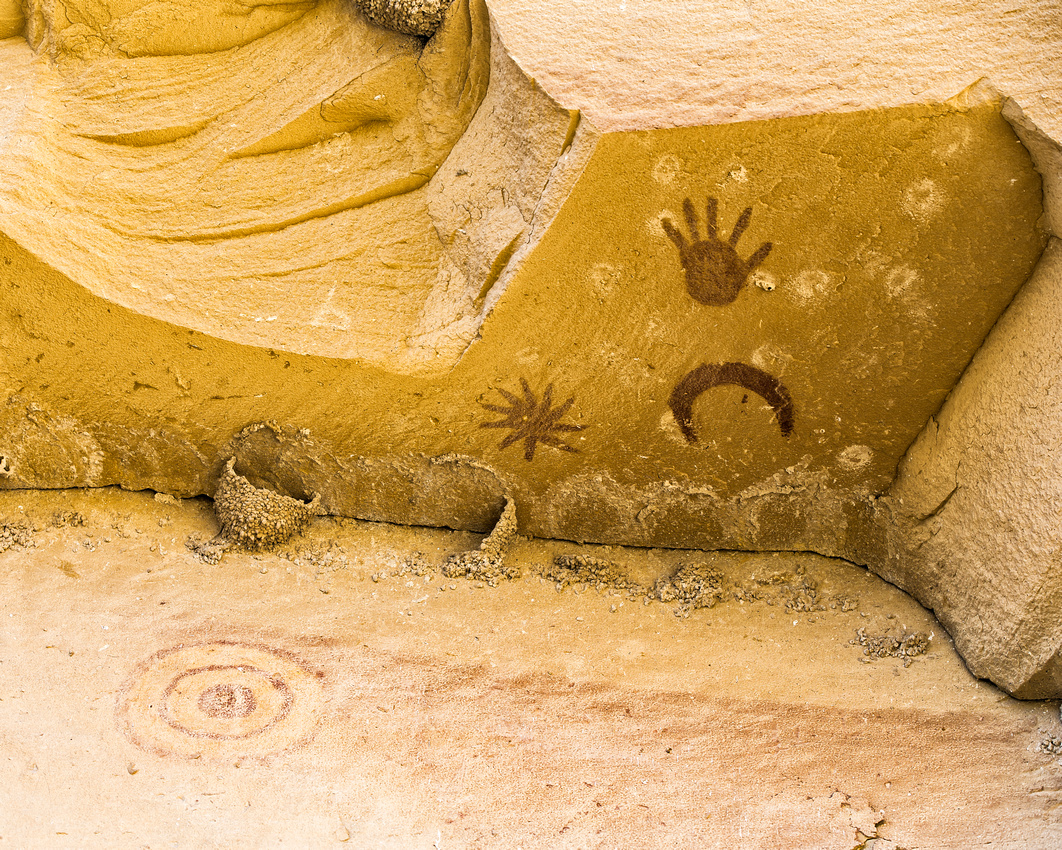 Representations of Comet Halley during its return in 1066. Left: From the Bayeux Tapestry, commemorating the Battle of Hastings. The Latin inscription reads “They marvel at the star.” Right: Petroglyphs at Chaco Canyon in New Mexico. The bright star and crescent moon likely depict the appearance of the supernova of 1054 (which produced the Crab Nebula) and the series of concentric circles with streamers to the right is likely a depiction of the comet. Photograph courtesy Michael Lloyd of Wild Light Imaging Studio.
Representations of Comet Halley during its return in 1066. Left: From the Bayeux Tapestry, commemorating the Battle of Hastings. The Latin inscription reads “They marvel at the star.” Right: Petroglyphs at Chaco Canyon in New Mexico. The bright star and crescent moon likely depict the appearance of the supernova of 1054 (which produced the Crab Nebula) and the series of concentric circles with streamers to the right is likely a depiction of the comet. Photograph courtesy Michael Lloyd of Wild Light Imaging Studio.
The return of 1531, in addition to being the first of the ones that Halley used in his calculations, is scientifically important for another reason. The German philosopher Petrus Apianus (Peter Apian), then a professor at the University of Ingolstadt in Bavaria, called attention to the fact that the comet’s tail always pointed away from the sun. It would be centuries before the explanation of this phenomenon was worked out – the solar wind in the case of ion tails, and solar radiation pressure in the case of the more visually prominent dust tails.
Since its return in 1759, Comet Halley has returned three more times. In 1835 it was recovered on August 6 by Father Etienne Domouchel and Francesco de Vico in Rome, en route to its perihelion passage in mid-November. It became as bright as 1st magnitude and exhibited a tail up to 20 degrees long, and was extensively studied by the astronomers of the era, including John Herschel – son of Uranus discoverer William Herschel – from the Cape of Good Hope in South Africa, and Friedrich Bessel in Germany. Bessel, in particular, made detailed studies of the “jets” in the inner coma, and surmised – correctly, as it turned out – that these acted as what are today known as rocket engines and, via Isaac Newton’s Third Law of Motion, caused the accelerations that had been observed in other comets, notably 2P/Encke. These motions, now called “non-gravitational forces,” are discussed as part of last week’s “Special Topics” presentation.

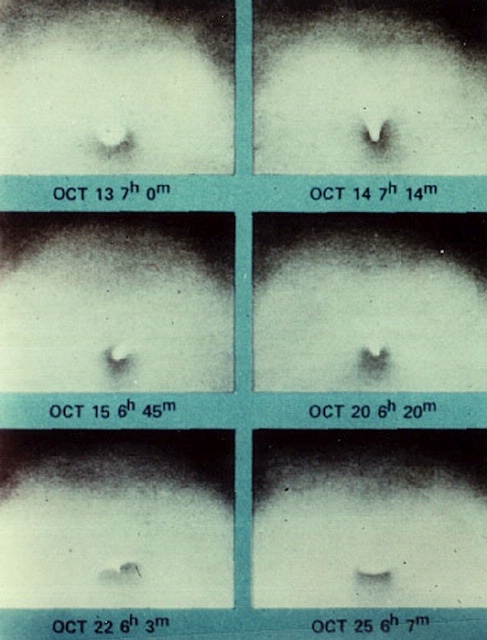 LEFT: Representation of Comet Halley traveling through Leo during its return in 1531, as rendered by German philosopher Petrus Apianus (Peter Apian) at Ingolstadt, Bavaria. The sketches show the comet’s tail pointing away from the sun. RIGHT: Sketches of the inner coma of Comet Halley in 1835 made by Friedrich Bessel, showing jetting activity.
LEFT: Representation of Comet Halley traveling through Leo during its return in 1531, as rendered by German philosopher Petrus Apianus (Peter Apian) at Ingolstadt, Bavaria. The sketches show the comet’s tail pointing away from the sun. RIGHT: Sketches of the inner coma of Comet Halley in 1835 made by Friedrich Bessel, showing jetting activity.
Comet Halley’s 1910 return, with perihelion passage taking place on April 20, was eagerly awaited by the astronomers of the time, in part because the viewing geometry would be excellent, but also because astro-photography and other relatively modern observing techniques had been developed. It was recovered on September 11, 1909, by Max Wolf at Heidelberg Observatory in Germany, being about 16th magnitude at the time. It brightened steadily after that, and was close to 8th magnitude when it disappeared into evening twilight in early March 1910.
Following conjunction with the sun, the comet emerged into the morning sky in early April, already a conspicuous naked-eye object of 2nd magnitude with a short dust tail. It continued brightening as it approached Earth – minimum distance being 0.151 AU on May 20 – and by the middle of May had become as bright as magnitude 0 with a tail in excess of 30 degrees. Shortly before its closest approach it passed directly between Earth and the sun, but while several attempts were made to observe it in transit across the solar disk, these were all unsuccessful, indicating that any solid component must be very small – which we now know to be true. Meanwhile, on the morning of May 19 the comet’s tail swept from well in front of Earth to well behind it, with measurements indicating a length of between 120 and 140 degrees – the longest cometary tail that has ever been observed.
Numerous scientific investigations were obviously carried out during the comet’s 1910 return. Among the more important of these involved the Eta Aquarid meteor shower, which peaks in early May and is best visible from the southern hemisphere, and the Orionid meteor shower which peaks during the third week of October. Both showers -- which have peak rates of 20 to 40 meteors per hour -- had been believed to be associated with Comet Halley, but the studies carried out during the 1910 return verified this relationship for both showers.
As dramatic as the comet’s 1910 return was, there was also a downside. The cyano radical CN, often confused with the poisonous gas cyanogen, had previously been detected in comets spectro-scopically, and since it seemed possible that Earth
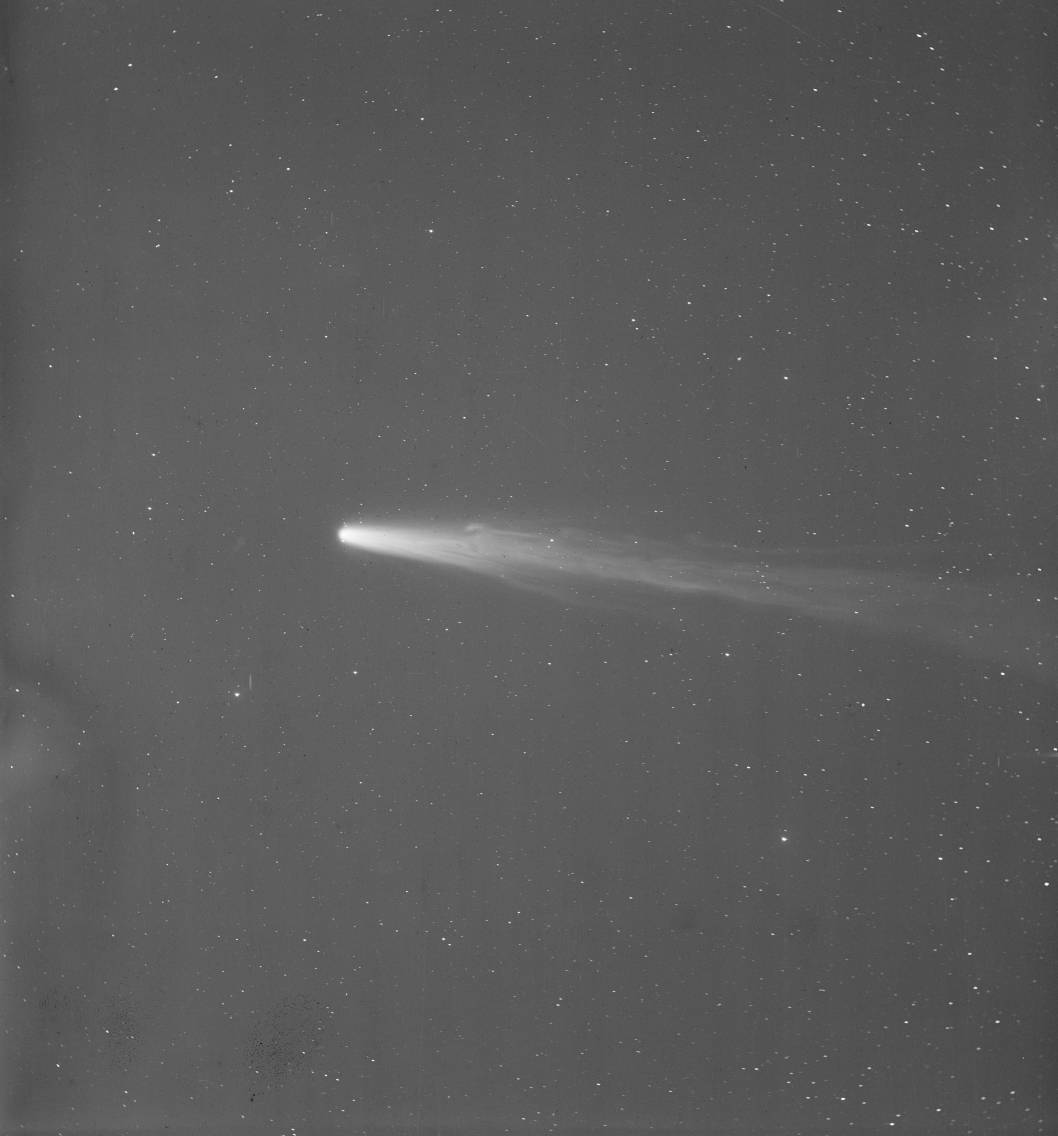
A somewhat more lighthearted anecdote involves the American writer Samuel Clemens, better known under his pen name Mark Twain. He had been born in 1835, just two weeks after Comet Halley’s perihelion passage, and in his 1909 autobiography, in referring to himself and the comet, pointed out: “The Almighty has said, no doubt: ‘Now here are these two unaccountable freaks; they came in together, they must go out together.’ ” Twain passed away of a heart attack one day after the comet’s perihelion passage in 1910.
Comet Halley most recently returned in 1986, and that return is discussed in detail as this week’s “Comet of the Week.” As is pointed out there, the 1986 return had significantly less favorable viewing geometry than did the return of 1910, and much of the general public – who also had to contend with significantly increased light pollution – was disappointed. It still found its way into popular culture, one of my favorite examples being the Mary Chapin Carpenter song “Halley Came to Jackson,” which describes the true story of Pulitzer Prize-winning author Eudora Welty who was shown the comet as a baby in 1910 and who saw it again in 1986.
The comet will be at aphelion (heliocentric distance 35.1 AU) in late 2023, and thereafter starts the journey back to the inner solar system. Perihelion next occurs on July 28, 2061, and although the viewing geometry will be much different than it was in 1986, it will still not be especially favorable. At perihelion it will be near inferior conjunction some 21 degrees due north of the sun and, although perhaps as bright as magnitude 0, it will probably be difficult to observe. Prior to perihelion it will be observable in the morning sky, and after perihelion it will be fairly conveniently placed in the evening sky, possibly still as bright as magnitude 0 or 1, and perhaps with a rather long apparent tail. The elongation from the sun does not get especially high and the show will be fairly brief, however.
The return after that, with perihelion passage on March 27, 2134, is much better. Six weeks after perihelion, on May 6, the comet will pass only 0.096 AU from Earth – the closest it has come to our planet since the 9th Century – at which time it may be as bright as magnitude -2. Unfortunately for observers in the northern hemisphere, it will be at the high southerly declination of -81 degrees at that time, and even more unfortunately for all concerned, the moon will be full. Perhaps prospective comet-watchers of that era will be able to travel to other vantage points, i.e., beyond the moon, for the show.
As for me . . . clearly there is no way I will live long enough for the 2134 return, but if I’m still alive I would be 103 when Comet Halley returns in 2061. All I can say is, we’ll see.
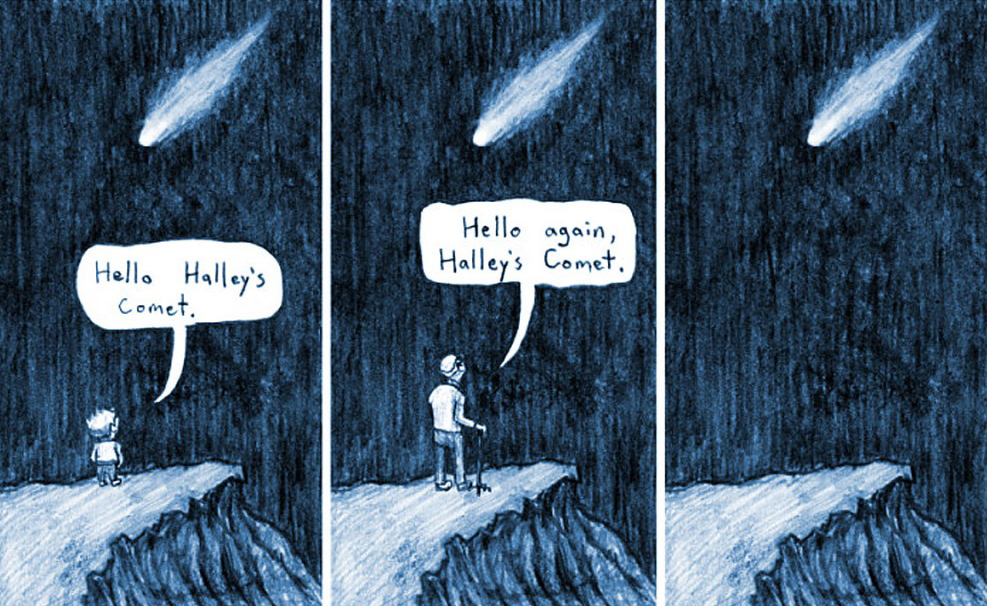 Comet Halley and the passage of time. Unidentified source.
Comet Halley and the passage of time. Unidentified source.
“Special Topics” archive
Ice and Stone 2020 home page
Earthrise Institute home page